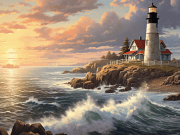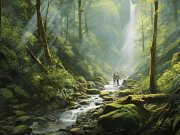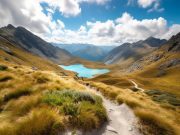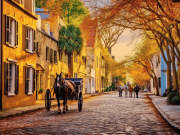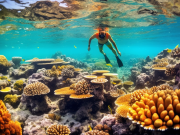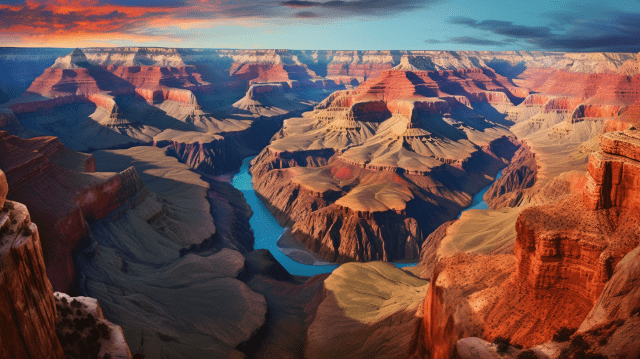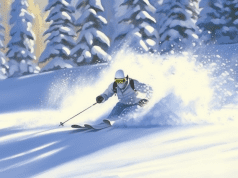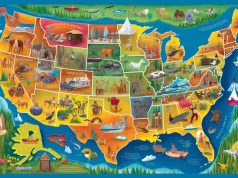Are you ready to experience the awe-inspiring beauty of one of America’s most iconic natural wonders? The Grand Canyon is a destination that should be on everyone’s bucket list. Its vastness and beauty are truly breathtaking, leaving visitors feeling humbled by nature’s power.
This guide will take you through the best viewpoints and hiking trails, helping you make the most out of your visit. As you explore the Grand Canyon, be prepared for an adventure like no other. You’ll witness stunning vistas from dizzying heights, hike through rugged terrain, and even ride down the mighty Colorado River.
Whether you’re looking for a challenging hike or just want to relax and soak in the views, this guide has something for everyone. So pack your bags and get ready to experience true freedom in one of America’s greatest natural treasures – the Grand Canyon.
Key Takeaways
- The Grand Canyon is a must-visit destination with stunning views and a fascinating geological history.
- Visitors can witness breathtaking vistas from various viewpoints, with Mather Point, Desert View Watchtower, and Yavapai Point being the best for sunrise and sunset.
- Hiking opportunities range from beginner-friendly to challenging trails, with the South Kaibab Trail and Bright Angel Trail being popular routes.
- Visitors should prioritize responsible tourism practices, such as Leave No Trace, to minimize the impact of tourism on the environment and ensure the longevity of the natural wonder.
Understanding the Grand Canyon’s Geography
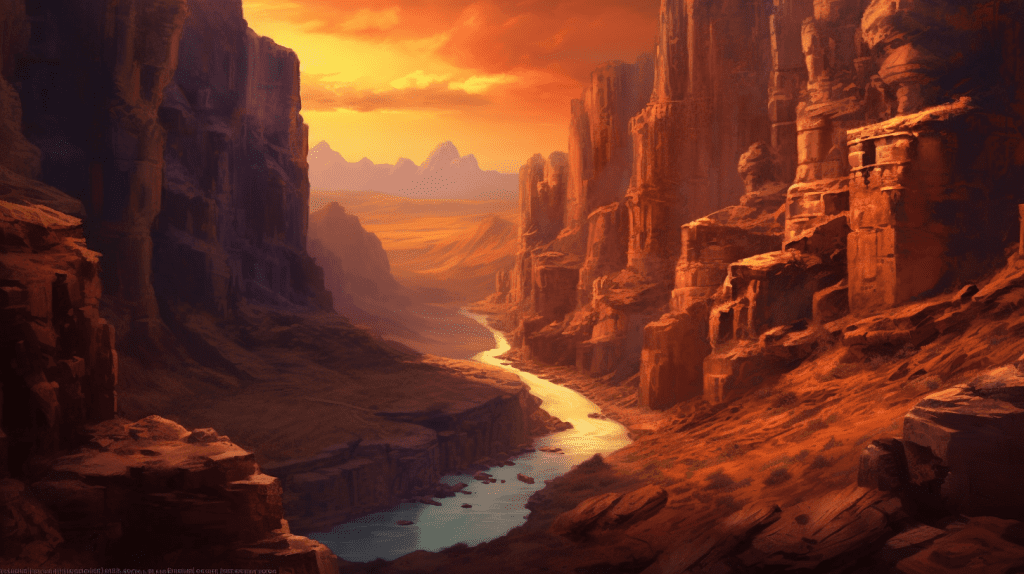
You’re going to love learning about the Grand Canyon’s geography, it’s like peeling back the layers of an onion to reveal its many secrets.
The Grand Canyon formation is a fascinating geological masterpiece with rock layers that date back millions of years. Each layer tells a story of the ancient environment and climate conditions that existed at different times in history.
You’ll be amazed by how the Colorado River carved through these layers over time, creating one of the most magnificent natural wonders on earth.
Now that you have an appreciation for its geology, let’s talk about how to get to the Grand Canyon without missing any breathtaking views along the way.
Getting to the Grand Canyon
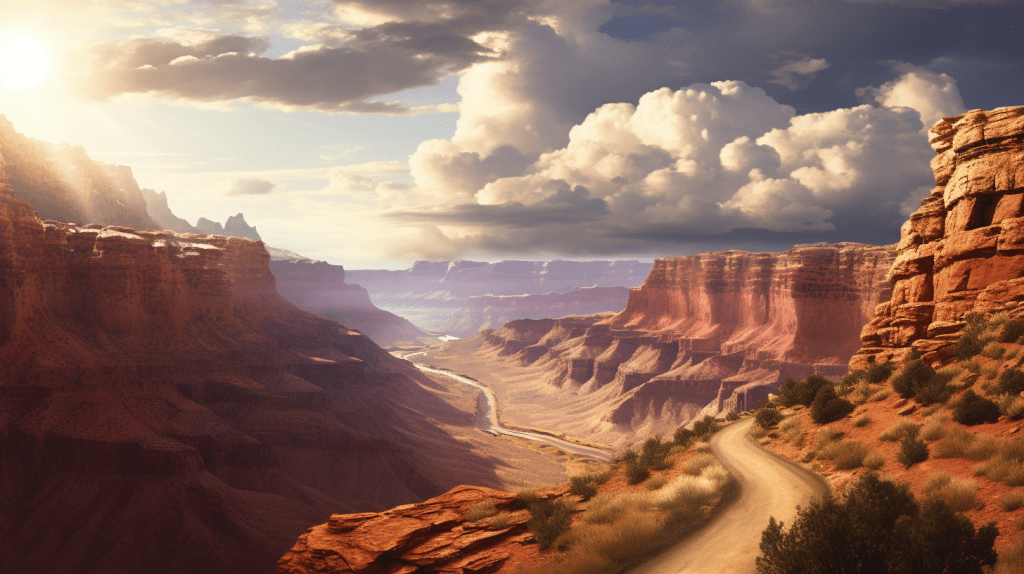
Once you arrive in Arizona, it’s easy to get to the Grand Canyon by car or shuttle. If you’re driving, there are several transportation options available including rental cars, taxis, and private shuttles. The park has ample parking facilities at each entrance so finding a spot shouldn’t be too difficult. However, during peak season, it’s best to arrive early in the morning before the crowds start pouring in.
Now that you’ve made it to the Grand Canyon, let’s explore some of the best viewpoints for sunrise and sunset.
Best Viewpoints for Sunrise and Sunset
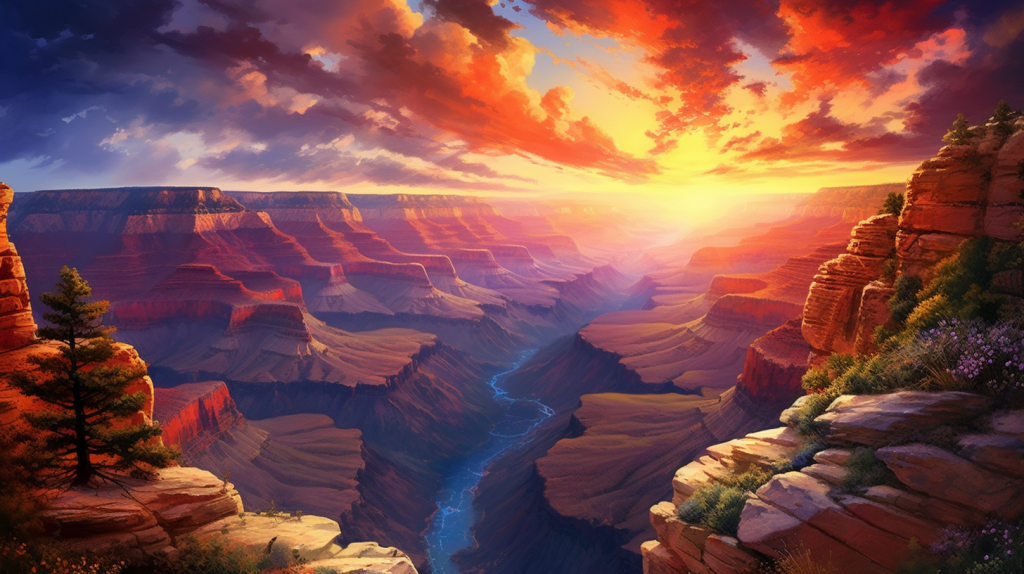
When it comes to witnessing the breathtaking beauty of sunrise and sunset at the Grand Canyon, you can’t go wrong with Mather Point. This iconic viewpoint offers stunning panoramic views that will leave you in awe.
Another great option is Desert View Watchtower, which not only provides a gorgeous setting for watching the sun rise or set but also features a historic Native American tower to explore.
And don’t forget about Yavapai Point, where you can watch as the colors of the canyon change before your very eyes. These three viewpoints are must-see spots for anyone looking to experience one of nature’s most spectacular shows.
Mather Point
From Mather Point, you’ll have a breathtaking panoramic view of the Grand Canyon’s vastness and rugged beauty. This viewpoint is perfect for capturing stunning photographs of the canyon at sunrise or sunset.
There are also plenty of hiking options available from Mather Point, including trails that lead down into the canyon for a more up-close-and-personal experience. As you stand at this iconic location, take in the sweeping vistas and feel your spirits lift with a sense of freedom in this natural wonderland.
As you move on to explore further, don’t miss out on visiting Desert View Watchtower. It offers an entirely different perspective on the Grand Canyon’s majesty and history.
Desert View Watchtower
Get ready to be blown away by the stunning views and rich history of Desert View Watchtower – you won’t want to miss this tower!
As you make your way through the Grand Canyon, exploring its wonders and marveling at its beauty, be sure to stop by Desert View Watchtower. Not only does it offer some of the most breathtaking vistas of the canyon, but it also has unique architecture that tells the story of its past.
Built in 1932 as a tribute to Native American cultures, the tower was designed by architect Mary Colter who incorporated elements from various tribes into her creation. From intricate murals on the walls to hand-carved wooden doors, every inch of this tower is steeped in history and culture.
Take your time climbing up its spiral staircase and enjoy panoramic views of the canyon from each level. Once you reach the top, you’ll feel like you’re on top of the world. But don’t stay too long – there’s more to see at Yavapai Point just ahead!
Yavapai Point
You’ll be amazed at the panoramic vistas waiting for you at Yavapai Point, where the breathtaking beauty of the Grand Canyon stretches out before you. This viewpoint offers an unparalleled view of the geological formation that took millions of years to create.
Yavapai Point also has a rich history and significance, as it was named after a tribe that once lived in the area and served as a lookout point during World War II.
If you’re looking for nearby accommodations, there are several lodges and hotels within close proximity to Yavapai Point, including Bright Angel Lodge and El Tovar Hotel.
For dining options, try Maswik Cafeteria or Arizona Room Restaurant for delicious meals with stunning views.
As you soak in all that Yavapai Point has to offer, keep in mind that there are even more best viewpoints for panoramic views throughout the Grand Canyon National Park.
Best Viewpoints for Panoramic Views
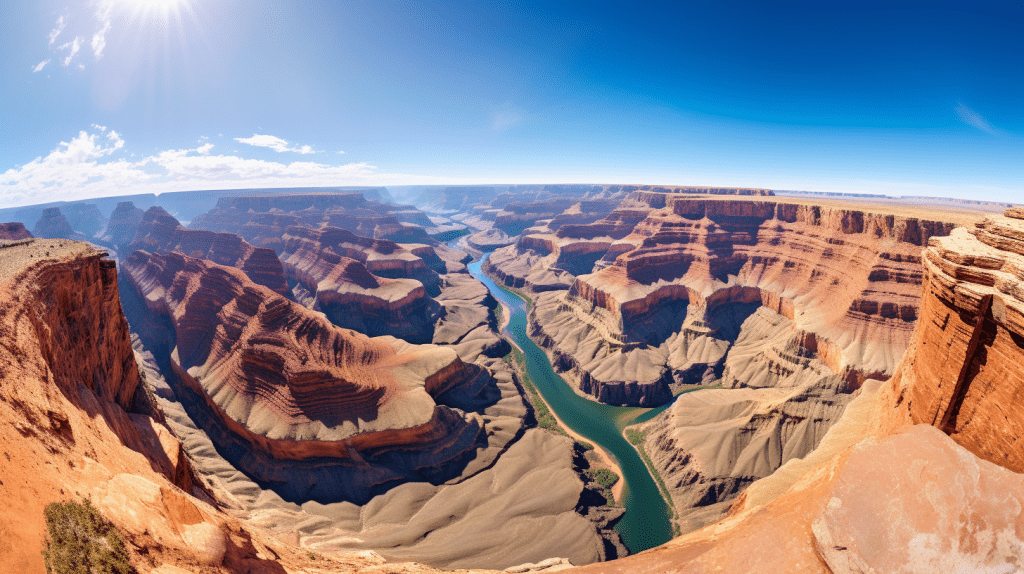
To fully appreciate the grandeur of the Grand Canyon, take a moment to visit the best viewpoints for panoramic views.
Start by heading over to Lipan Point, which offers breathtaking vistas of both the eastern and western rims.
Then make your way to Desert View Watchtower, where you can capture stunning panoramas from one of the highest points in the park.
Finally, don’t miss out on Moran Point, known for its unobstructed views of the Colorado River snaking through the canyon below.
For panoramic photo tips, be sure to visit during golden hour when the lighting is ideal or bring along a wide-angle lens to capture as much of this natural wonder as possible.
The best times to visit are early morning or late afternoon when crowds are thinner and temperatures are cooler.
Now that you’ve taken in these awe-inspiring panoramic views, let’s explore some unique perspectives at other must-see viewpoints in Grand Canyon National Park.
Best Viewpoints for Unique Perspectives
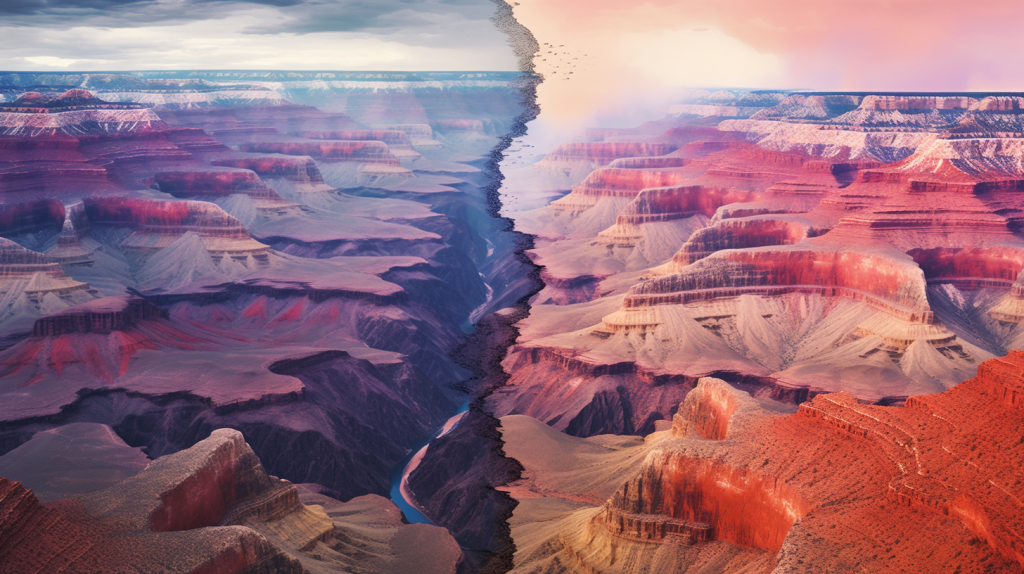
You’re in for a treat as we uncover some mind-blowing perspectives that will take your breath away at the Grand Canyon National Park. If you’re looking for unique vantage points and hidden gems, then there are plenty of spots to explore.
One such viewpoint is Shoshone Point, which offers a secluded spot with stunning views of the canyon. Here, you can take in the sweeping vistas without crowds and noise.
Another hidden gem is Yavapai Point, where you can witness the unusual geological formations and layers of rock up close. From this viewpoint, you’ll be able to see how the Colorado River carved through the rock over millions of years.
These viewpoints provide an extraordinary perspective on one of America’s most iconic landmarks that few others get to experience.
After taking in these breathtaking sights, it’s time to hit the trails! Let’s explore some beginner-friendly hiking routes that are perfect for getting started in this incredible park.
Best Hiking Trails for Beginners
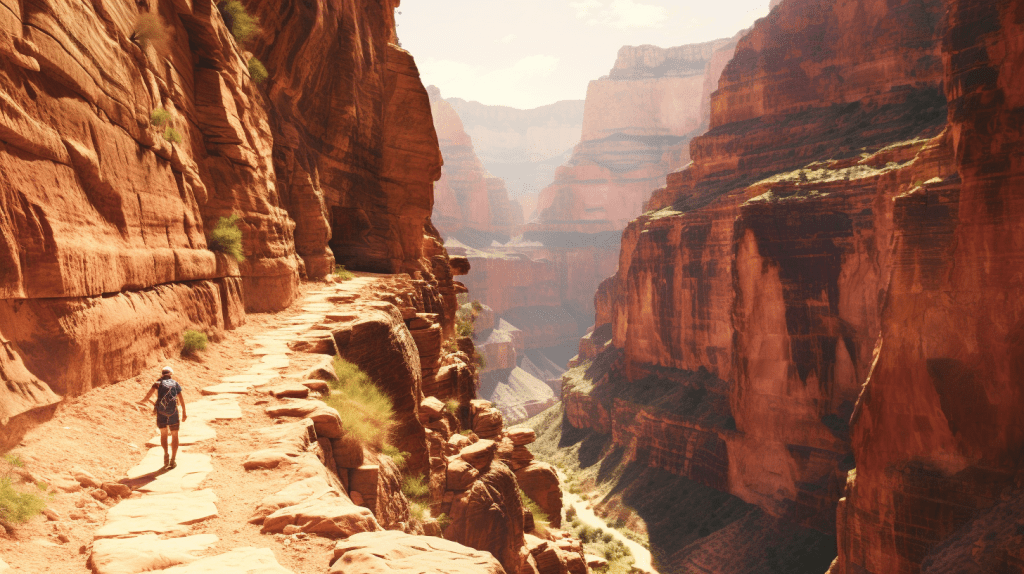
If you’re seeking an immersive experience in one of America’s natural wonders, then discovering the beginner-friendly hiking routes at Grand Canyon National Park is a must-do.
The park offers several trails that are perfect for those new to hiking or looking for a more leisurely walk through the canyon. Trail difficulty ranges from easy strolls along a flat terrain to moderate hikes with some elevation gain and rock scrambling.
It’s essential to take safety precautions when embarking on any hike, such as carrying enough water, wearing proper footwear, and staying on marked paths. Recommended gear includes sturdy shoes or boots with good traction, a hat, sunscreen, and sunglasses.
Hydration tips include drinking water before starting your hike and bringing at least one liter of water per person per hour of activity.
Once you’ve completed these beginner-friendly hikes, consider challenging yourself with more advanced trails like Bright Angel Trail or South Kaibab Trail.
Best Hiking Trails for Experienced Hikers
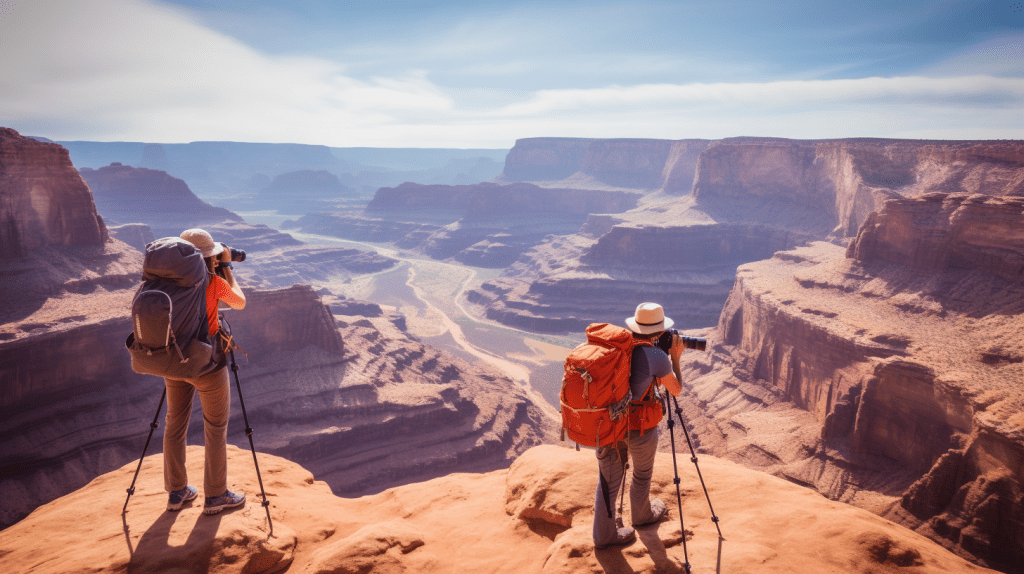
Experienced hikers will find a range of challenging and rewarding routes within Grand Canyon National Park, each offering unique opportunities to connect with nature and push their physical limits. From steep inclines to narrow ridges, the challenging terrain provides an adrenaline rush like no other.
Some of the most scenic routes include the South Kaibab Trail, which offers stunning panoramic views of the canyon, and the Bright Angel Trail, which takes you through lush forests and past cascading waterfalls. However, safety precautions should always be taken on these trails as they can be treacherous if not properly prepared for. Gear essentials such as sturdy hiking boots, plenty of water and snacks, sun protection, and emergency supplies are a must.
Once you have conquered these challenges though, there’s nothing quite like the sense of accomplishment that comes with reaching your destination. As we move into discussing day hikes versus overnight backpacking trips in our next section…
Day Hikes vs. Overnight Backpacking
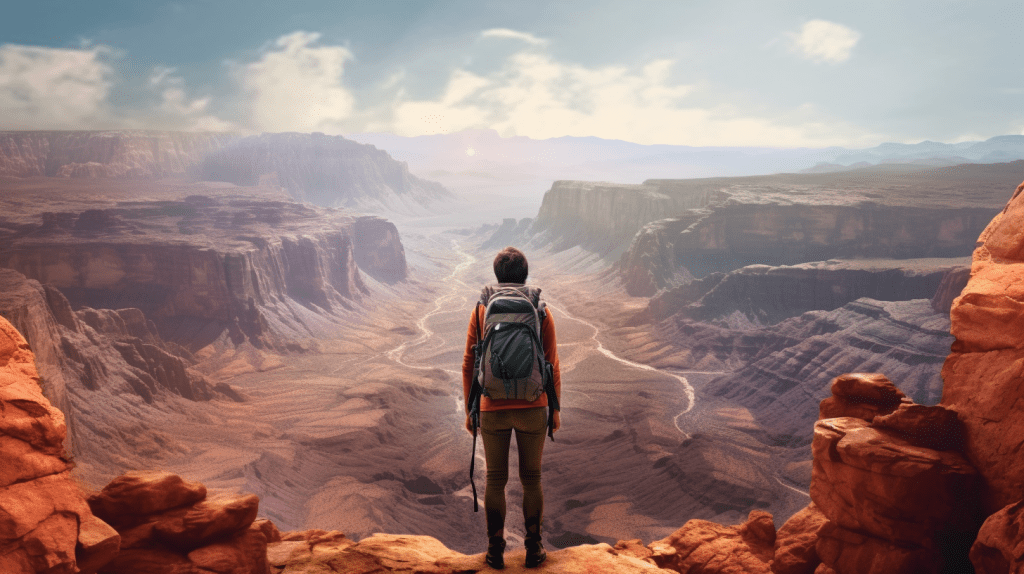
Venturing into the wilderness of Grand Canyon National Park, one can either opt for a quick day hike or embark on an immersive overnight backpacking trip, each offering its own set of challenges and rewards.
Day hikes are great for those who want to experience the beauty of the canyon without committing to a longer trip. They provide a chance to take in stunning views and witness the changing colors of the rocks as the sun moves across the sky. Pros of day hikes include flexibility in terms of time management and less equipment needed while cons include limitations in terms of trail options and distance covered.
On the other hand, overnight backpacking trips offer a more intimate experience with nature and allow hikers to truly disconnect from daily life. However, they require greater physical endurance and planning skills. Pros include experiencing solitude with nature, exploring remote areas while cons include potential hazards such as extreme weather conditions or getting lost without proper navigation skills.
Safety tips for both activities include staying hydrated, packing adequate food and supplies, monitoring weather forecasts before heading out, wearing appropriate gear including sturdy shoes with good traction, and avoiding hiking alone whenever possible.
Now that you know about day hikes versus overnight backpacking trips at Grand Canyon National Park along with some safety tips associated with them, let’s talk about wildlife spotting opportunities in this majestic wonderland!
Wildlife Spotting
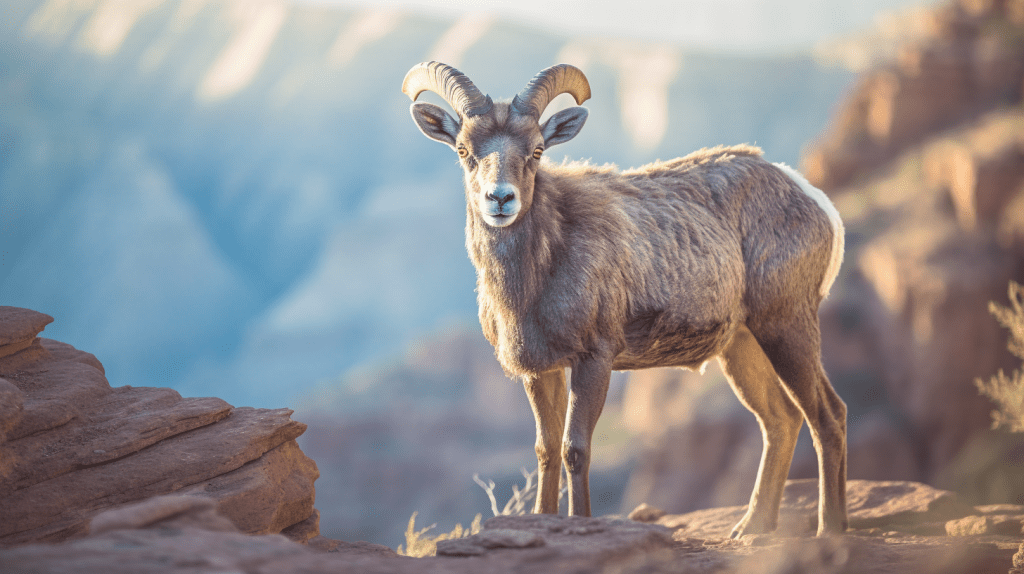
Get ready to spot some amazing wildlife during your visit to Grand Canyon National Park – you’ll be amazed by the creatures you might see!
Keep an eye out for bighorn sheep, elk, and mule deer grazing along the rim. You might also catch sight of a coyote or a golden eagle soaring overhead. But remember, these animals are wild and their behavior can be unpredictable. It’s important to keep a safe distance and not disturb them in their natural habitat.
The park has implemented several conservation initiatives to protect the diverse wildlife that call it home. So, take the time to appreciate these magnificent creatures while respecting their space.
As you prepare for your journey into nature, don’t forget your camera! In the next section, we’ll give you some photography tips so you can capture all of your unforgettable moments at Grand Canyon National Park.
Photography Tips
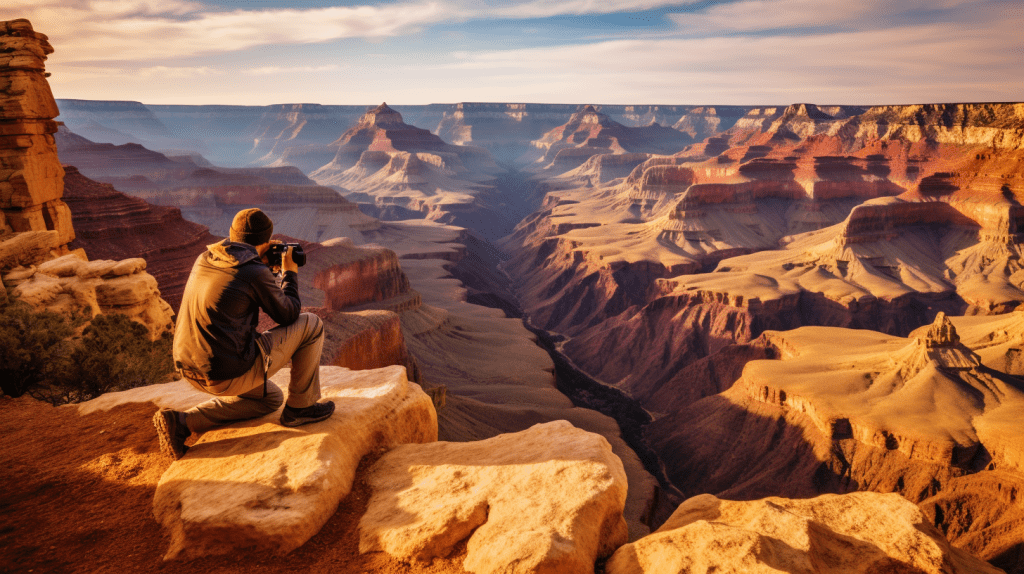
If you’re looking to capture the perfect shot of the Grand Canyon, timing is everything. The best time of day to photograph the canyon is during the golden hours – just after sunrise or just before sunset – when the light is soft and warm.
As for equipment, a DSLR camera with a wide angle lens will help you capture more of this magnificent landscape in your shots.
Best Time of Day to Photograph
The best time to photograph the Grand Canyon is during golden hour, which occurs just after sunrise and just before sunset. During this time, the sun is low on the horizon and creates a warm and golden light that enhances the natural beauty of the canyon. The light also adds depth and texture to your photos, making them more visually interesting.
Keep in mind that weather conditions can affect the quality of your photos during golden hour, so check for clear skies or partly cloudy conditions. When taking pictures at other times of day, be aware of harsh sunlight which can create unwanted shadows and highlight blown-out areas in your shots.
As you move onto equipment recommendations, make sure to bring a tripod or steady surface for stability while shooting in low-light conditions.
Equipment Recommendations
For optimal photo quality, consider bringing a tripod or stabilizing surface when shooting during golden hour at the Grand Canyon. This will steady your camera and reduce blur caused by shaky hands or uneven surfaces.
Other must-have gear includes a wide-angle lens to capture the vastness of the canyon, polarizing filters to enhance colors and reduce glare, and extra batteries and memory cards for extended shooting sessions.
If you’re hesitant about investing in equipment, renting is a great option as it allows you to try out different gear without committing to purchasing it. However, if you plan on visiting multiple times or exploring other scenic locations, buying your own equipment may be more cost-effective in the long run.
As freedom seekers who crave adventure, having reliable gear will ensure that you’re able to capture breathtaking moments without any technical difficulties getting in the way.
Now that we’ve explored essential equipment recommendations for photographing the Grand Canyon during golden hour, let’s transition into helicopter tours, another exciting way to experience this natural wonder from a unique perspective.
Helicopter Tours
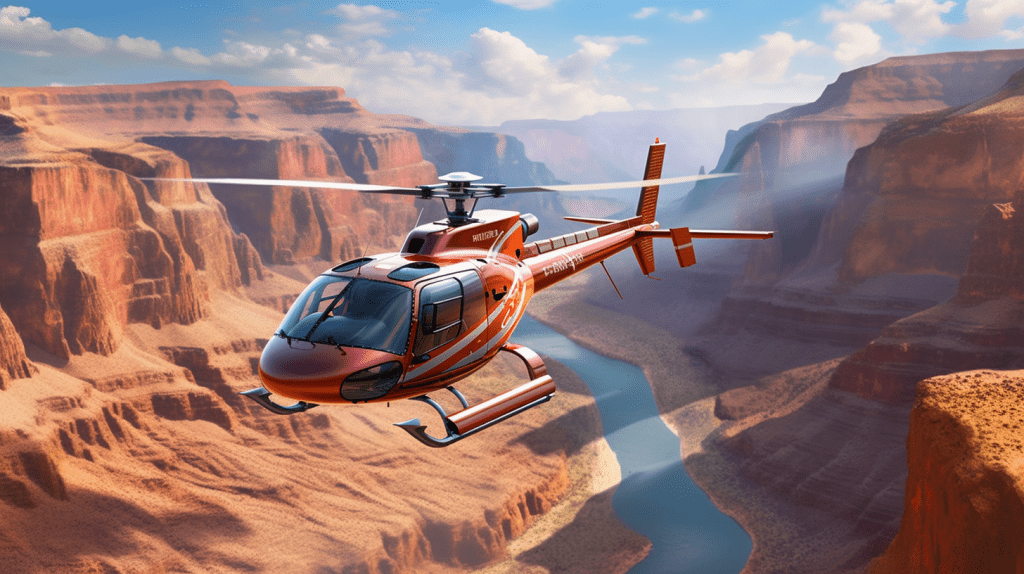
Hop on a helicopter tour for a breathtaking aerial view of the Grand Canyon, giving you a new perspective on its immense size and natural beauty. The helicopter tours are perfect for those who want to experience the stunning views without having to hike or climb.
Prices vary depending on the tour company, but it’s important to note that there are safety regulations in place to ensure your safety during the tour. You’ll be amazed by the bird’s eye view of the canyon and its unique rock formations, providing an unforgettable experience.
As you descend from your helicopter ride, get ready for an exciting adventure ahead as we delve into river rafting in one of the world’s most magnificent natural wonders.
River Rafting
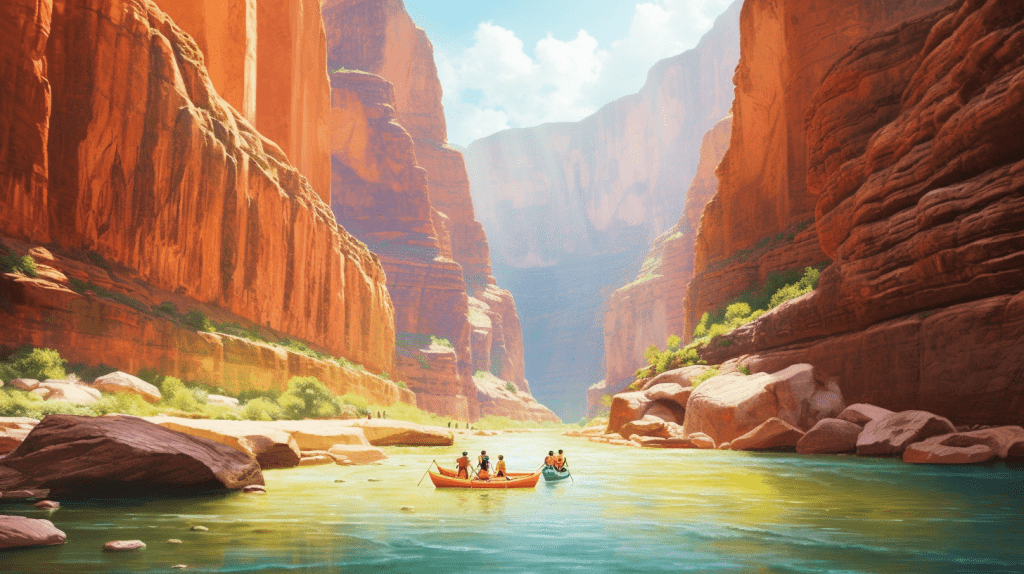
You’ll have a blast navigating the rapids of the Colorado River while river rafting in the Grand Canyon, with over 22,000 cubic feet of water per second rushing through some of the most challenging sections.
As you make your way down the river, take comfort in knowing that safety is always a top priority for outfitters like Arizona Raft Adventures and Grand Canyon Expeditions. These popular companies provide all necessary equipment and experienced guides to ensure an unforgettable experience that’s also safe.
After your thrilling ride on the river, be sure to check out nearby attractions such as Havasu Falls or Horseshoe Bend for even more breathtaking views.
Nearby Attractions
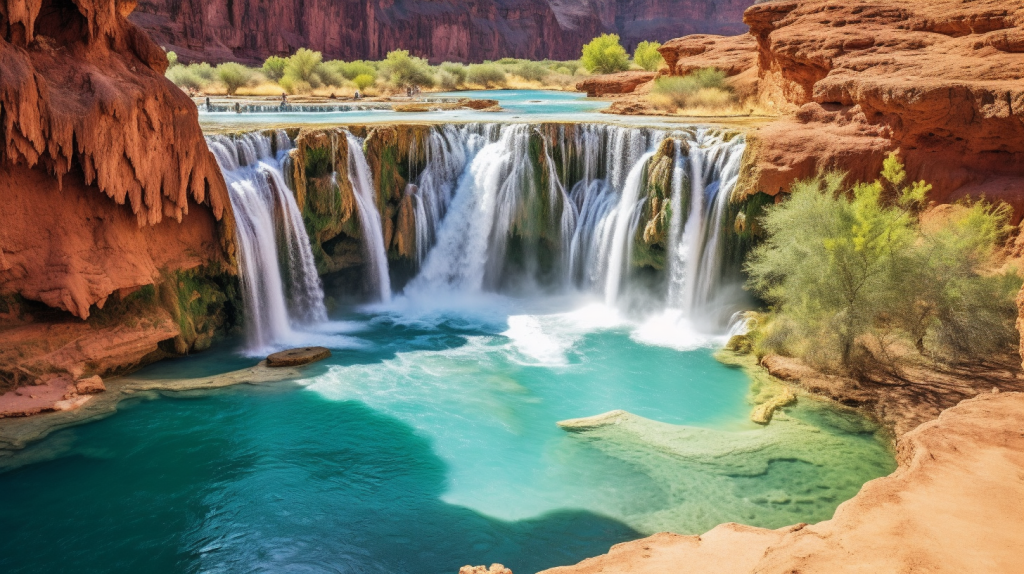
Now that you’ve experienced the thrill of river rafting through the Grand Canyon, it’s time to explore some nearby attractions.
Sedona is a popular destination known for its stunning red rock formations and spiritual energy.
The Glen Canyon National Recreation Area offers opportunities for boating, fishing, hiking, and more along the Colorado River.
And don’t forget about the impressive engineering feat that is Hoover Dam – take a tour to learn about its history and significance.
Sedona
If you’re looking for a stunning day trip from the Grand Canyon, Sedona is just a short drive away and offers breathtaking red rock formations and plenty of hiking trails to explore.
Start your adventure by taking one of the many vortex tours available in Sedona, where you can experience the energy centers that are believed to have healing properties.
Afterward, head over to Red Rock State Park for some scenic hiking trails that offer panoramic views of the surrounding landscape.
Don’t forget to bring your camera as you’ll want to capture every moment of this picturesque destination.
As you leave Sedona behind and make your way towards Glen Canyon National Recreation Area, take a moment to reflect on the beauty that surrounds you and prepare yourself for even more awe-inspiring sights ahead.
Glen Canyon National Recreation Area
As you wind down the scenic road towards Glen Canyon National Recreation Area, prepare to be amazed. The vast expanse of shimmering blue water stretches out before you. This beautiful park covers over 1.2 million acres and is home to Lake Powell, a man-made reservoir on the Colorado River. It offers endless boating opportunities for those who love being on the water. You can also find some of the best fishing spots in Arizona here. A variety of fish species like largemouth bass, striped bass, and catfish just waiting to be caught.
If you’re looking for adventure and freedom, this is definitely a place worth exploring. And speaking of dams (see what I did there?), next up we have Hoover Dam. It’s another engineering marvel that’s sure to leave you in awe!
Hoover Dam
Located on the border between Arizona and Nevada, Hoover Dam is an engineering marvel that will leave you in awe. Built during the Great Depression, this massive structure stands at 726 feet high and stretches across the Colorado River. It was once the tallest dam in the world and still remains one of the largest concrete structures ever built.
Not only is it impressive to look at, but it also generates enough power to serve millions of people in both states. If you’re interested in learning more about its history and construction, take a guided tour or visit the museum on-site.
As you prepare to explore further into Grand Canyon National Park, keep in mind seasonal considerations such as weather changes and trail closures.
Seasonal Considerations
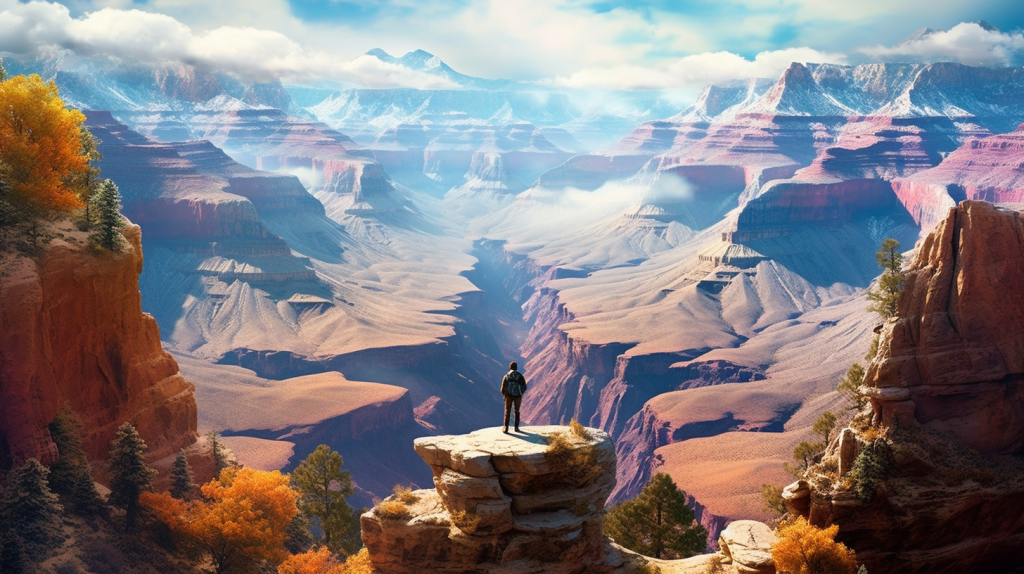
Don’t miss out on the stunning seasonal changes of the Grand Canyon, with its array of vibrant colors and unique hiking experiences.
Here are three things to consider when planning your trip:
1) Climate considerations: The Grand Canyon is a desert environment, so temperatures can vary greatly throughout the year. Be sure to check weather conditions in advance and pack accordingly.
2) Peak visitation: Summer months tend to be the busiest, while spring and fall offer milder temperatures and less crowds. Consider visiting during these times for a more peaceful experience.
3) Hiking opportunities: Each season offers different hiking experiences, from snowshoeing in winter to wildflower spotting in spring. No matter which season you choose to visit, there’s always something new to discover at the Grand Canyon.
As you plan your trip, keep in mind that conservation efforts play an important role in preserving this iconic natural wonder for future generations to enjoy.
Conservation Efforts
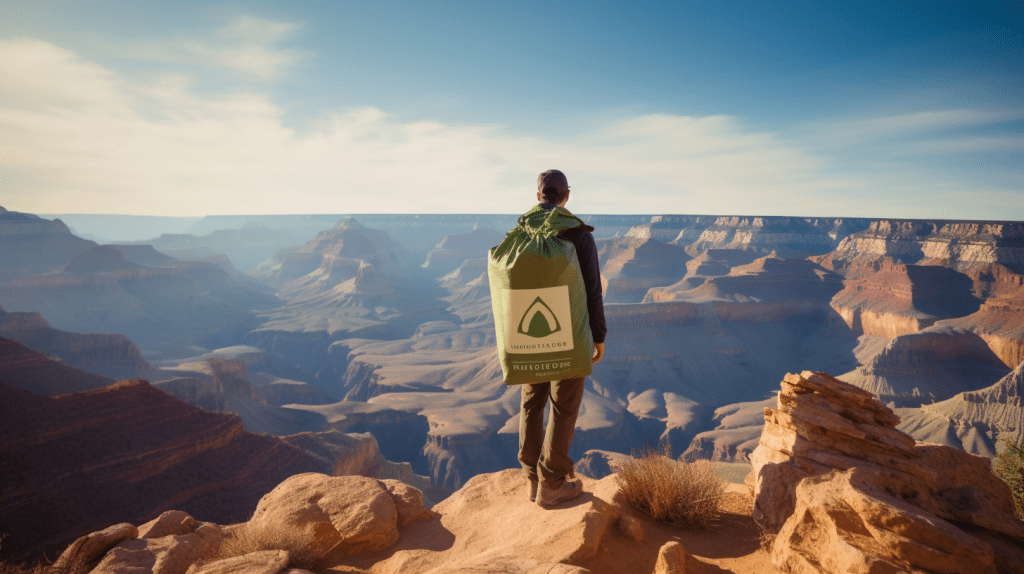
You’ll be amazed to know that the Grand Canyon Trust has helped protect over 5 million acres of land surrounding the Grand Canyon.
This is a testament to the community involvement and dedication towards preserving this natural wonder.
With tourism being a major source of revenue for the area, it’s important to balance economic growth with conservation efforts.
The impact of tourism on the environment can be significant, but through responsible practices and initiatives like Leave No Trace, visitors can minimize their footprint and contribute to maintaining the natural beauty of the area for generations to come.
It’s up to all of us to do our part in protecting this majestic site and ensuring its longevity as one of America’s most iconic landmarks.
Frequently Asked Questions
What is the best time of year to visit the Grand Canyon?
The best time to visit the Grand Canyon is during the off-peak season, which is from November to February. The weather conditions are mild and less crowded, allowing for a more peaceful and adventurous experience.
Are there any restrictions on hiking trails or viewpoints?
Before embarking on any hike in the Grand Canyon, bear in mind that permit requirements and safety guidelines must be followed. Research the trail you intend to take and ensure you have the necessary permits before setting off.
Can I bring my pets with me to the Grand Canyon?
You can bring your pets to the Grand Canyon, but there are pet restrictions on hiking trails and some viewpoints. However, there are pet-friendly accommodations available nearby for you and your furry friend to enjoy while exploring the area.
Is there Wi-Fi or cell phone service available in the park?
You’re in the heart of nature, feeling free and alive. Suddenly, you need to check your phone for an important message. Don’t worry! The Grand Canyon has Wi-Fi availability and cell phone coverage in certain areas. Enjoy your trip without losing touch with the world.
Are there any cultural or historical sites to visit within the Grand Canyon National Park?
Discover cultural significance and Indigenous history at the Grand Canyon National Park. Visit Tusayan Museum and Ruin, Hopi House, and Desert View Watchtower for a glimpse into the past. Immerse yourself in history as you explore.
Conclusion
Congratulations, you’ve just finished exploring the majestic Grand Canyon!
As you reflect on your trip, you may be interested to know that the Grand Canyon is one of the most visited national parks in the United States. In fact, according to the National Park Service, over 6 million people visit the Grand Canyon each year!
But there’s a reason why so many people flock to this natural wonder. The breathtaking views and unique hiking experiences make it a must-see destination for any nature lover.
From watching sunrise and sunset from different viewpoints to rafting down the Colorado River, there’s something for everyone at the Grand Canyon.
Remember to take care of this beautiful place by following Leave No Trace principles and supporting conservation efforts. And if you ever find yourself missing those stunning panoramic views or exhilarating hikes, don’t hesitate to plan another trip back to this incredible destination.
Happy travels!


